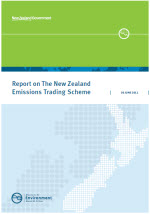 In the latest episode in Hot Topic’s election coverage, forestry consultant Piers Maclaren looks at a forestry issue that seems to be missed by all the major parties.
In the latest episode in Hot Topic’s election coverage, forestry consultant Piers Maclaren looks at a forestry issue that seems to be missed by all the major parties.
New Zealand faces a major carbon problem in the period from 2023-2038, resulting from the imbalanced age-class structure of our plantation forest estate. Let me explain.
Forestry is a cheap and easy way to sequester carbon, but it is not a total global solution because at best it could possibly offset some 10% of the carbon the planet is likely to emit over the next 100 years from the burning of coal. Afforestation is merely the converse of deforestation, which has been responsible for something like 20% of the increase in atmospheric carbon dioxide since the industrial revolution. Afforestation can help reverse some of that portion.
Afforestation takes a landscape of low carbon density (for example, pasture or short scrub) and changes it to one of high carbon density – a forest. If the forest consists of an even balance of trees of all ages, then it will be in a steady-state situation — neither a carbon sink nor a carbon source, but
carbon neutral — and will remain in that state in perpetuity. The act of establishing a forest therefore constitutes a sink, but the maintenance of a forest is carbon neutral. This applies to all types of forest, and it is irrelevant whether the trees are felled with a chainsaw or by storm damage; whether the trees are removed from the forest, converted to some product and ultimately oxidised, or whether the biomass decays within the forest; or whether the trees are removed in clusters, or are widely spaced individuals. The point is that the removal of some component of the forest — for example a harvestable block of trees within the estate — is exactly counterbalanced
by the growth of all the other blocks.
Continue reading “Planting boom hangover on its way: get more trees in the ground, starting now”
Like this:
Like Loading...
 The Minister for Economic Development Steven Joyce had a curious op-ed in the Herald earlier this week. It was aimed at those pesky people who obstruct progress when government tries to remove roadblocks in the way of business development.
The Minister for Economic Development Steven Joyce had a curious op-ed in the Herald earlier this week. It was aimed at those pesky people who obstruct progress when government tries to remove roadblocks in the way of business development.
 I liked the sub-heading to a Guardian article on Friday. “The theory that cutting carbon emissions costs us growth is bunk, in fact, it’s an economic opportunity.” The
I liked the sub-heading to a Guardian article on Friday. “The theory that cutting carbon emissions costs us growth is bunk, in fact, it’s an economic opportunity.” The  In the latest episode in Hot Topic’s election coverage, forestry consultant Piers Maclaren looks at a forestry issue that seems to be missed by all the major parties.
In the latest episode in Hot Topic’s election coverage, forestry consultant Piers Maclaren looks at a forestry issue that seems to be missed by all the major parties. Simon Johnson continues his series of guest posts looking at the Australian and New Zealand carbon pricing schemes.
Simon Johnson continues his series of guest posts looking at the Australian and New Zealand carbon pricing schemes.